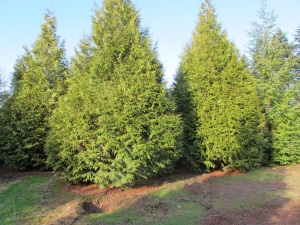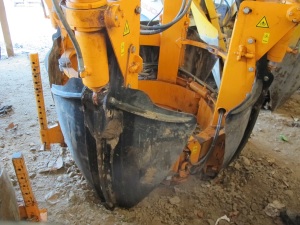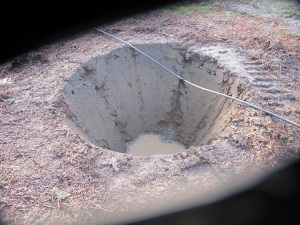Winter Planning: What Size Tree to Buy?
The snow is deep, the temperatures well below freezing. It’s a good time to think about what projects to undertake this year. My friend Evan Schneider, who was in the Peace Corps with me in Cameroon, recently bought a house in Portland, Oregon. He and his wife are retired and realized that whatever landscaping they do, they don’t want to wait 20 years for a shade tree to actually produce enough shade for the two of them to sit in the shade all afternoon reading good books.
In general, I buy the smallest tree available, not the largest. I know that a small tree loses a smaller percentage of its roots when it is dug up for transplanting. Or if it has been growing in a plastic tub, I figure the less time it is in that tub, the less time the roots have to encircle the pot and get tangled. So I was surprised that they had purchased a thirty-foot tall maple tree, and had it installed. I visited them recently, and saw that the tree seems to be thriving.
Evan took me to meet the people who had done the job. The company is called Big Trees Today, in Hillsboro OR, and they specialize in growing big trees in the ground, and then digging them up and installing them. Dan Hickman, the owner, is now in his mid-thirties and is selling some trees that he planted when he was in junior high school (and working for his dad).
Dan said they generally buy small, bareroot trees, plant them in the ground, and then move them 3 times before selling them. After a tree is about 2 inches diameter it is dug up and moved. Digging it up means that the roots are severed, which stimulates new roots to grow and to branch out from the older roots. Then when the trunk is about 5 inches in diameter, it is dug up and moved again. Finally at 9 inches in diameter it is moved for the final time before it is sold. Depending on the kind of tree and how fast it grows, it might be root pruned again without digging it up – by digging down and severing roots.
I once moved a crab apple tree for a woman who had planted it when her son was born. She and her family were moving, and wanted to move the tree, even though her son was, by then, twelve years old (I think). I told her I could do it as a two-step process: First, I would cut the roots along a dotted line about two and a half feet from the trunk. I alternated thrusting the shovel deep into the soil and leaving a shovel-width undisturbed. I did that in the fall, I believe, and then moved the tree the next year. When it was time to dig it up, I dug around the tree three feet from the trunk. That way the previously severed roots had been given time to fork out and grow new feeder roots which were largely undisturbed when I moved it.
Most commercial firms that move trees have a special tractor-mounted tool called a tree spade. It is fitted around the tree and several big blades are hydraulically powered to slice deep into the earth creating a root ball that is shaped a bit like a huge ice cream cone (though not as pointy).
Dan Hickman told me that it is important that the root ball not fall apart during the digging, the transporting, or the planting. His firm is located where the soil is high in clay, which helps the root ball stick together, especially if kept moist. But they also wrap the root ball, first in an open wire cage, then in burlap.
I have seen trees with root balls wrapped in synthetic burlap, which must be removed at planting time. I once dug up a tree that was 7 years old and was not growing well, only to find that its roots were encased in burlap that had not broken down. Dan Hickman said the burlap they use disintegrates in 3 to 4 months, and they leave it in place. Only after it is planted do they cut away any burlap they can at the soil surface. Me? I’ve always removed the burlap.
I asked Dan what was the biggest tree he ever moved. He told me that they once moved an historic camperdown elm (Ulmus glabra ‘Camperdownii’) that was 106 years old but in the way of an upcoming building project. It had a rootball 16 feet wide and it weighed 73,000 pounds – over 36 tons! He and his crew root pruned it in the spring, and then dug it up and moved it in the fall. It is doing fine.
What else should you know about buying a big tree? Find a company that has plenty of experience. A company that has invested in a tree spade is probably a good bet, though it can be done by hand. Be sure to have the tree planted at the right depth – you will want it to sit with its trunk flare exposed, not buried.
Set up a watering system so that your big tree never gets thirsty. Digging a big tree severs roots, even if it has been root pruned and has a compact root system. A transplanted tree has fewer root hairs to pick up water and minerals. It makes sense to use a timer that will turn on your watering system on a schedule. You can use a soaker hose or an irrigation system with emitters to deliver the water. It will require more water in the heat of August than in the spring or fall, so will have to adjust it accordingly.
Finally, create a “donut” of bark or wood chips around the tree, covering the roots, but not touching the trunk. Mulch will keep down weeds and grass, and keep those dudes with weed whackers away from the trunk. You don’t want the bark damaged, and string trimmers or lawnmowers can be lethal.
So I’ve re-thought my position about planting big trees. I’m not exactly a spring chicken anymore, so if I want to see another mature tree on my property, I’ll consider buying a big tree. And maybe even having an expert – with the right tools – install it.
Henry lives in Cornish Flat, NH and is a UNH Master Gardener. His Web site is www.Gardening-Guy.com. He is the author of 5 books.





